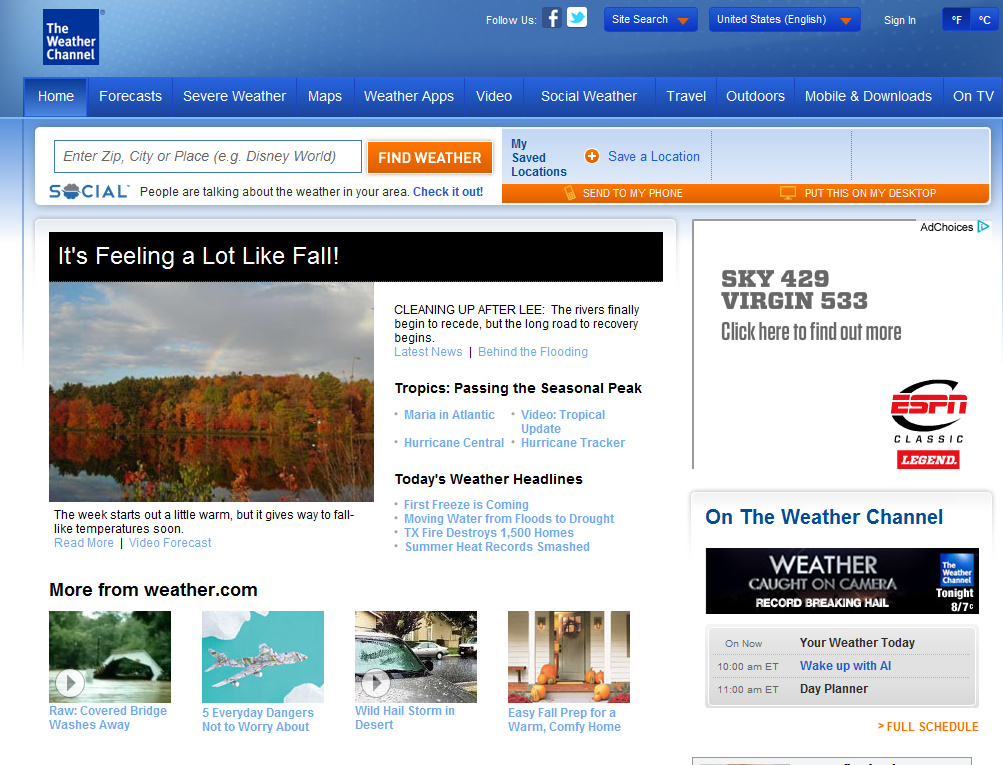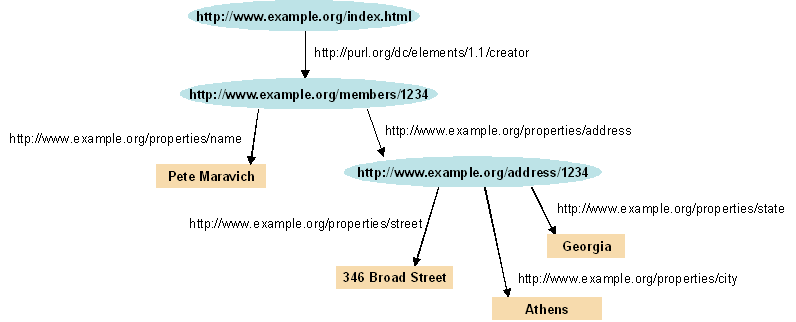An introduction to naming and reference on the Web
Henry S. Thompson
28 January 2012
I owe much of what I understand about the Web to Tim Berners-Lee,
along with Dan Connolly, Harry Halpin, Jonathan Rees and Larry Masinter
Brian Cantwell Smith has hugely influenced my approach to all things computational
- He first brought the flight name examples to my attention over 30
years ago
- And stimulated me to think harder about the URI/link distinction just a few months ago. . .
To say the Web is ubiquitous, at least in the so-called developed world,
is commonplace to the point of vacuity
Ubiquity alone doesn't require philosophical enquiry
- After all, paved roads are ubiquitous (and important) too, but they
don't engender a lot of philosophical interest
What I aim to show you today is that we do need to study the
mechanisms of the Web
- In particular, that means the thing that makes the Web a web
URIs turn out to be something quite new
And getting agreement on what they really are has proved. . .challenging
Understanding them is a crucial part of understanding how to make the Web
work better for everyone
Their very name proclaims them to be names
- But they are not quite like any kind of name we've ever seen before
There is a moderately clear official consensus about URIs
- Explicitly specified in IETF's RFC 3986
- Summarised and extended in W3C's WebArch
'URI' stands for
- Uniform
- There's a standard generic syntax and (partial) semantics
- Identifier
- URIs are identifiers, that is, names
(not addresses)
- Resource
- What it is they identify -- anything at all
We will need to refer to parts of URIs as they are written:

More examples:
http://www.ed.ac.uk/ftp://ftp.funet.fi/pub/mirrors/perl/mailto:ht@inf.ed.ac.uk [that's a bit weird. . .]file:///D:/Documents/HTalks/PhilWeb_2012/slides.html [this talk]http://localhost/ht/Documents/HTalks/PhilWeb_2012/slides.html [likewise]http://www.ltg.ed.ac.uk/~ht/travel.html#travelhttp://maps.google.co.uk/maps?q=10+Crichton+Street,+Edinburgh&layer=c&
sll=55.944586,-3.187494&cbp=13,332.96,,0,1.84&cbll=55.944532,-3.18738&
hl=en&sspn=0.006295,0.006295&ie=UTF8&hq=&hnear=10+Crichton+St,+Edinburgh+EH8,+United+Kingdom&
ll=55.944532,-3.18738&spn=0.000012,0.006727&t=m&z=17&
vpsrc=0&panoid=e8EPc2P5vtC6b-oE8SlGiwhttps://mail.google.com/mail/?ui=2&shva=1#inbox
Before we dive further into the details, let's try to bring what's hidden
out into view
What actually happens when someone clicks on a link to my home page:
- User clicks on a link in a page displayed by a Web browser
- Browser looks at URI behind the link and identifies
http scheme - Browser looks
up domain name part of the URI via DNS and gets an IP address
- Browser sends HTTP GET message to
port 80 at that address with the path part of the URI
- Browser computer (the client) operating system and Ethernet hardware
- Disassemble the message into packets
- Send them
via TCP/IP to a gateway
- Which routes them through the Internet to their destination
- Where they
are reassembled into a message by the destination computer (the server) hardware and
operating system
- And delivered to the
computer program (the web server) listening on port 80
- Web server maps path onto
its file system
- Server sends header specifying mime type
text/html plus
file contents back to the client [see above wrt TCP/IP] - Client dispatches response to browser
Notice the URI appears in the address bar
- Browser interprets message body as HTML, displays page to user
We'll call the process embodied in steps 3–8 accessing
the URI
Back to URIs
At first 'resource' seems like a vacuous label
- If anything at all can be a resource
- Knowing something is a resource tells you nothing
But consider the word referent
- Anything can be a referent
- When/if someone/something refers to it!
So, being a resource is not about some intrinsic
property of something
- It just means, being identified by a URI
Who gets to say what the resource is that a URI identifies?
- The owner of the URI
- Just like the coiner of a new word
We'll use the phrase "referent of a URI" for the resource
which the minter of a URI intends for it to identify
Who is the owner (sometimes also called the 'minter')?
- For the kinds of URIs we care about
- (mostly ones that begin
http and
https, maybe ftp a bit)
- the owner of the URI is the owner of the domain name
at the beginning of the URI
- Actually, domain names aren't owned, only leased
- But that's a can of worms I don't propose to open further today
In principle, all URIs are opaque
- That is, no conclusions about the shape of the space referents should be drawn from the shape of the set of their identifiers.
- In natural languages this is called l'arbitraire du
signe—the arbitrariness of the sign
- You can't tell anything about the relationship between cats, dogs
and puppies just from the words 'cat', 'dog' and 'puppy'
In practice, for most http URIs, this is false
- We expect URIs to 'make sense'
- We expect the referents of apparently related URIs to
actually be related
- For example
http://www.inf.ed.ac.uk/teaching/courses/inf2a/http://www.inf.ed.ac.uk/teaching/courses/inf2b/
- It's entirely up to minters to manage this
Giving your URIs consistent names contributes to the utility of
the Web as a shared information space
- Consistent with one another
- Consistent with the nature of their referent
It's part of what is referred to as the social
contract
Now things start to get interesting
In the beginning, there was only one (legitimate) way
- Access it
- If you get something back, turn it in to a presentation
- Experiencing (reading/watching/listening to) that presentation will
answer your question
- (The illegitimate way is to read the URI itself, see previous
discussion about opacity)
Isn't that what URIs are really for?
- Short (in theory) answer
- Actually, no!
- The preceding slide is wrong
- It's perfectly OK to mint URIs with no intention to ever produce a
web page at all
http://www.ltg.ed.ac.uk/~ht/Concepts/philosophy- There, I just did it.
- Longer (in practice) answer
- 3 billion web page authors can't be wrong
- But (in the terms of the standards)
- what they've authored
- and what you can access
- are
not the referents of the URIs
- They're representations of those resources.

'Representation' names a pair: a character sequence and a media type.
- The media type specifies how the character sequence should be interpreted
- For example JPG or HTML or MP3
would be likely media types for representations of, respectively
- an image of an apple
- a news report about an orchard
- a recording of a Beatles song
Just as, in order to
interpret utterances or enscriptions, we need to know the language they are expressed in
The result of a successful access of a URI consists mostly of a representation
A browser goes beyond just retrieving a representation
- From representation to, shall we say, presentation
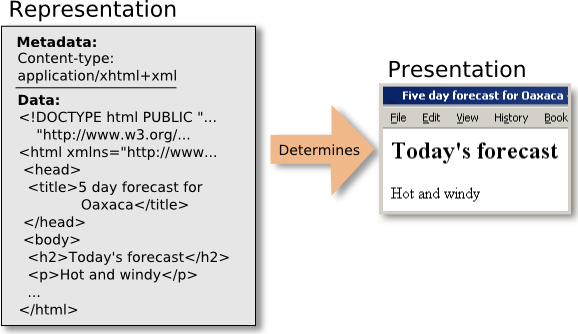
We can combine our story about representations with the behind-the-scenes narrative
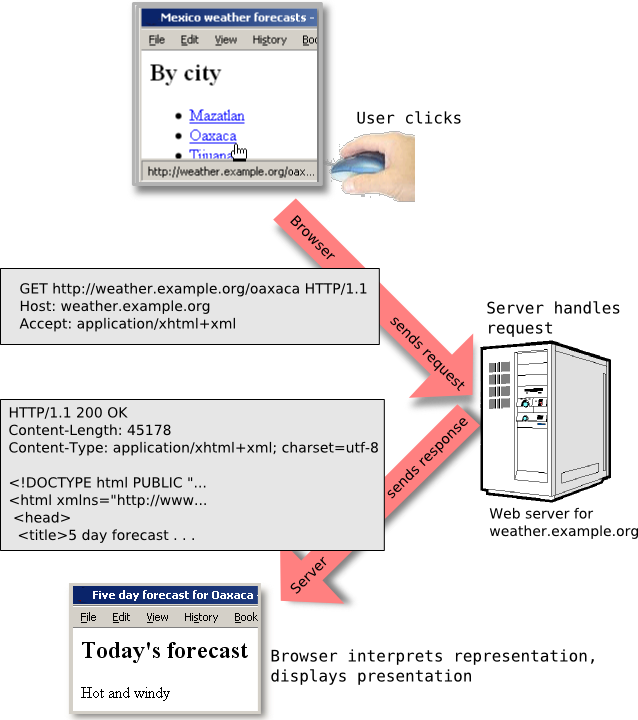
Notice the HTTP/1.1 200 OK line in the response
- That's where the famous
404 Not Found would appear if
the server couldn't find a representation for the URI - Remember this, it will be important later
Why make this distinction? Why isn't the web page itself
the resource?
- That is, the URI's referent, the resource identified by the URI
The distinction was barely there, if at all, in the earliest standard (RFC 1630)
- Which talks about "accessing" "objects on the network"
Thereafter, the distinction emerged over time
- As people reflected on how URIs were being used
- Considering, for instance, that the result of accessing a URI might change over time
- And that this was a good thing
- So the URI must be identifying something more abstract than the thing retrieved
From quite early on, as well, the idea arose of URIs without associated web pages
- For example from information scientists thinking about using URIs in electronic
library records
"The search for a physical
work was identical in all important respects to the search for a digital
work. . . . The need was clear for an
identifier system that spanned both the physical and digital worlds."
(John Kunze, personal communication)
We'll return to this idea later on.
There are a number of un-interesting reasons why accessing a URI may fail
to produce a representation
- The net is down
- The owner of the URI has failed to make one available
- The original owner has lost the domain
But there's a more interesting reason as well
- Some resources can't have a representation
Here's the official story about representations
A 'representation' is a
sequence of octets, along with representation metadata describing
those octets, that constitutes a record of the state of the resource
at the time when the representation is generated.
(from RFC 3986)A representation is data that encodes
information about resource state.
(from WebArch)The distinguishing characteristic of these resources [web
pages, images, etc.] is that all of their essential characteristics [are]
conveyed [by their representation]. We identify this set as “information
resources.”
(from WebArch)- A response code of
200 OKmeans the
response contains a representation of the referent of the requested URI
A weather report is certainly an information resource
- That is, its representation conveys all its 'essential characteristics'
- So doing a
GET on something like
http://weather.example.com/oaxaca makes sense
But what about a GET on
http://cities.example.org/oaxaca?
- If, as we might reasonably suppose, this URI is meant to identify
Oaxaca itself.
- Surely it's not possible for a representation to convey
Oaxaca's essential characteristics
So whatever response you get, it shouldn't be a 200 OK
But what should it be, if you have useful information to
offer about Oaxaca?
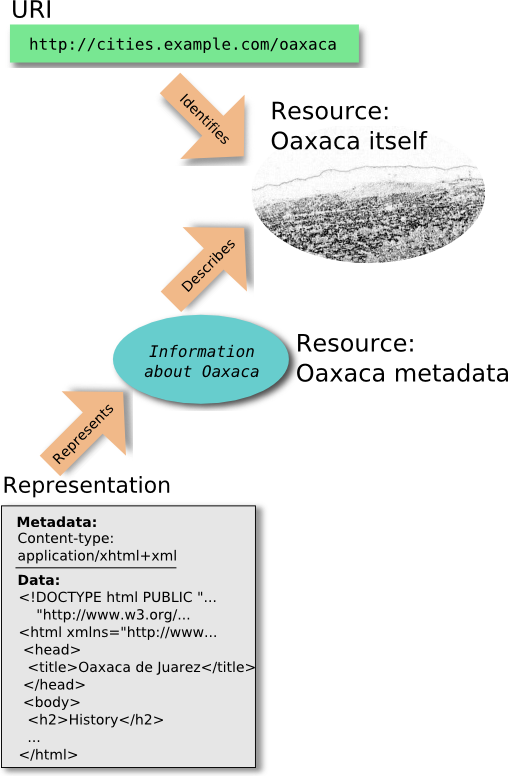
If what you have describes or depicts a
resource, as opposed to conveying its essential characteristics
- Then you have a representation of a different resource
- In our example, not Oaxaca, but a description of Oaxaca
So the officially correct response is something like
HTTP/1.1 303 See other
Location: http://cities.example.org/metadata/oaxaca.html
- Supposing that
http://cities.example.org/metadata/oaxaca.html identifies your web
page about Oaxaca
The browser interprets the 303 See other to mean "Do a
GET on the 'Location' URI instead"
- So you get useful information about Oaxaca without it, as it were,
claiming to be Oaxaca
Surely this is all a bit over the top?
Well, things and their descriptions are not the same
And when people started using URIs to make assertions (using RDF, on the
Semantic Web)
- They wanted to be able to say both
http://cities.example.org/oaxaca has a radish festival
every year on December 23rdhttp://cities.example.org/metadata/oaxaca.html was
written by Raphael Sabattini
URIS identify resources
Resources can be anything at all
Accessing a URI may yield a representation of (the current state of) its referent
- But some resources have no representation
- And others have more than one
Only information resources have representations
What about the fact that information resources (Voltaire's
Candide, Debussy's La Mer, today's issue of Le
Monde, Minard's visualisation of Napolean's Russian campaign) have parts
Do we have to make up URIs for all their parts?
How can we do that?
First Brian will expand on this,
- And then at the end of today's session I'll give a very partial answer
That's all pretty much OK, isn't it?
- A bit complex
- Uses words as technical terms in not completely obvious ways
- Some of the concepts are a bit soft/under-specified
No, it's not OK
In practice
- Too many people either don't know or don't care
- Virtually all users
- Most developers
- The Web has moved on
- Many background assumptions/motivations are no longer as important
as they once were
- Or are simply not true at all
- Some important things have always been missing
- The status of presentations
- The difference between URIs, links and link assertions
Not before time, I need to emphasise that there's a lot I've
ignored so far
- The Web browser is not the only user agent/client
http is not the only URI scheme- Human beings are not the only users
I'll branch out a bit with respect to the first point in a minute
- But a lot will remain unconsidered
Why did things go wrong?
The Web as the standards tried to capture it has not stood still
- The drivers for change have been many
- But the economic significance of the Web has got to be near the top
of the list
The Web is now more than a conduit for documents to read
- It's a means to a
variety of ends
- We use it to do things
- Share photographs, music and videos
- Play games
- Participate in communities
- And above all, buy and sell goods and services
The potential the Web offers for people to make money
influences behaviour in ways and at a pace that no after-the-fact standard can hope to match
Historically, URIs were mostly seen as simply the way you accessed web
pages
- Hand-authored, stored in files, relatively stable and simply shipped out on demand
Not any more
- Rarely hand-authored or
stable
- Rather, automatically
synthesised from 'deeper' data sources on demand
- Significantly influenced by aspects
of the way we initiate the access
Furthermore, the relation between retrieved representation and observed
presentation has changed enormously
The presentation a user experiences as a result of accessing a URI depends
- as much if not more on running Javascript programs embedded in the retrieved HTML representation
- and on the results of other, behind-the-scenes, resource accesses
- as it does on that HTML representation itself
For example, the representation you get by accessing the www.weather.com home page
Such a representation certainly captures all the 'essential
characteristics' of whatever it is that that URI identifies
- But via a much more complex route than was the case when
the theory was developed
- And in a way that seems almost circular
- That is, it's difficult if not impossible to speak accurately about
the resource identified by
www.weather.com- without
depending almost entirely on its attendant presentations
The Semantic Web names an initiative and a Web-based technology
- Aimed at automating the discovery and aggregation of information on
the Web
- For automatic exploitation
You could think of it as the marriage of Knowledge Representation and the Web
- With some Automated Reasoning thrown in
At its core is the idea of a web of assertions
One triple from that example:
Subject: http://www.example.org/index.html
Predicate: http://purl.org/dc/elements/1.1/creator
Object: http://www.example.org/members/1234
The subject is presumably meant to name an information resource
- But the predicate and object do not, because they are
- A concept (of being the creator (author) of a document)
- A person
The growth of the Semantic Web
- And more recently of its somewhat less ambitious offspring the Open
Linked Data movement
mean that huge numbers (at least billions) of such URIs are
in use
Accessing one of those URIs will in practice almost always either
- fail, with a
404 Not found - succeed, with a
200 OK- and a representation (usually in terms of more triples) of
information which is at least in part about the URI in question's referent
But per the official story accessing a URI which identifies a person
should never result in a 200 OK response!
We've identified a divergence between Web
standard/theory and Web practice
- SemWeb/LOD URI owners respond with
200 OK when they
'should not'
Not only does this matter in principle
- Because it suggests we just don't have the right theory about the way
the Web works today
It also matters in practice
- If, when users and developers look at the standards, they see things
that label commonplace behaviour as incorrect
- Behaviour which they themselves think is correct and unproblematic
- They will not respect the standards
In other words, laws that everybody breaks bring the law into disrepute
We need to look hard at the things we missed before
- The status of presentations
- The difference between URIs, links and link assertions
- Or, the importance of the context of use
Although URIs are a new kind of identifier, they share some
properties with other identifiers
- And the Philosophy of Language has struggled with the nature of
identifiers in ordinary language for many years
- With some potentially useful results
Other disciplines have something to contribute as well
- Information Science
- Philosophy of Computation
For the vast majority of web developers, it's all about what I've been
calling presentation
Maybe we should make that more central in our theory
Here's a sketch of how we might start
- A browser implements a function from a
URI and a browser state to a URI plus the substance of a request:
- A server implements a function from a URI
plus a substance from a request and a
server state to a substance in a response:
- A browser also implements a function from
a substance from a response, a browser state and a web state to
a presentation:
Compose all three of these, and a browser implements a function from URIs
to presentations (with dependencies on three kinds of state: browser,
server and web):
People responsible for URIs know this
- They understand what they are doing in terms of this
story
- Their goal is precisely to effect the connection between a particular URI and
a particular presentation
B2 (and thus B) depends on Web state
- because e.g. rendering an HTML page may involve appeals to B1∘S for stylesheets and scripts
- As well as to the whole of B for frames, embedded images, etc.
In principle this recursion could fail to terminate
- In practice this is extremely unusual
- Although I have heard anecdotal evidence that crawlers do sometimes
fall into unintended recursion tarpits
The stability over time of B for some URI is then what people are talking about
when they discuss persistence
We can outline some interesting classes of expected behaviour in these terms
- Once a particular instance of B is established, there is no
expectation that the resultant presentation will change in any way
- URIs
which present as images,
audio and video are often in this category
- Once a particular instance of B is established, there is an
expectation that the resultant presentation will not change
- but there is a
recognition that errors may need to be corrected
- URIs which present as
some form of transcription of documents created outside the Web are typically
in this category
- as are W3C Recommendations
- URIs whose presentations change only in accordance
with a published versioning policy
- A newspaper home page
- My home page
- A 'live' news blog
This space is much richer and more complex than the current theory allows for
The Information Scientists have struggled with the ontology of created
works for a long time
- Just what do we need to deal with when we consider, for example,
Charles Dickens's novel Martin Chuzzlewit
- I have here not one but two Martin Chuzzlewits

- Are they the same book?
- Yes and no, right?
- Same author, same story
- Same language
- Different publishers, different editions
- Different physical objects
IS have developed a detailed story about all this
- Known as FRBR
- Functional Requirements for Bibliographic Records
FRBR has a four-level ontology
- Work
"a distinct intellectual or artistic creation"; "an
abstract entity"
- Expression
"the intellectual or artistic realization of a work
in the form of [some] notation",
e.g. "variant texts"; first, second, . . . editions;
English original vs. French translation
- Manifestation
"the physical embodiment of an expression of a
work"; "all the physical objects that bear the same characteristics, in respect to both intellectual content and physical form"
- Item
"a single exemplar of a manifestation"; "a
concrete entity"
Not all of the FRBR architecture maps directly onto the Web situation
- But getting clear where it does
- And where it doesn't
- Would be of use to both communities
Some people in the IS community, notably Allen Renear, have made a start
on this
- But it needs a lot more work
Clearly there's a lot of it about
- But the official story about it is hopelessly vague
- In particular, with respect to what counts as acceptable (with
respect to the Social Contract) variation
We looked at this briefly under the heading of persistence
The Philosophy of Language offers another possible way in
Consider English words such as
this, here and tomorrow, as well as
you and I.
- Linguists call this class of words indexicals
On one well-thought-of Philosophy of language account, an indexical such as now has
- a single meaning
- but multiple interpretations
The meaning is fixed, the interpretation varies according to the context
of use
The meaning of now is something like "the time at which the utterance containing the word
is made"
- It is the same for every ordinary use of the word
But the interpretation
is, well, whatever time it happens to
be when the word is used
- and this of course changes all the time
More generally, the meaning of an indexical can be understood as a
function from contexts (that is, contexts of utterance) to interpretations
In a formal approach to all this, indexical meaning really is just an index
- Because context of utterance is modelled as a sequence
- E.g.
<[Henry S. Thompson], {[a lot of folk]}, 2011-09-13:18:00:05,. . .>
- So on this account the meaning of now is pretty much
just
The parallel with time-varying resources is clear
- But more work is needed to see if that observation can be cashed in
- In terms of a useful formal story
- Some aspects of the functional account of presentation given above
are a tiny step in this direction
Arguably, much of the focus of Web architecture discussions to date has
been misplaced
- That is, the significance of URIs on their own has been exaggerated
Words, after all, don't mean anything
- When considered as simply a sequence of characters or sounds
They have to be used before we can talk about their meaning
- And we have to know how they're used
Consider the following character sequence as if found on a piece of paper
in an otherwise featureless bottle on a desert island beach:
chat
Conversation? Cat? Something else altogether? There's no way to tell
It's words in use that have meaning
- So not just the external context
- But also the local, linguistic, context
One of the primary roles of "the philosophy of ..."
- Help the subject discipline by identifying parallels
- "Your problem is not new"
- And, good news, the solution is ...
- Alternatively, bad news, the prognosis is not good, sorry
Within the web community discussions about URIs use words such as 'identify' and 'denote', as well as 'name' itself
These are terms of art within the Philosophy of Language
- Is there a parallel here that can be helpful?
- Or is the implied connection mistaken and irrelevant?
- Or at worst even harmfully misleading?
In natural language, names are easily discoverable
That is, we know what to call things
- This is why even the Kripkeans can't dispense with descriptions
There is nothing corresponding to this for URIs
- Except search engines!
- Do I hear you say "aha, the extended mind"?
Ordinary language names function within specific linguistic contexts
What a name means depends on the details of the surrounding
utterance or sentence
Consider what at first seems like a very ordinary (imaginery) name:
EZY386 (short for easyJet 386)
Here are some example uses of this 'simple' name
- EZY386 will depart from gate E17 at 2010 [announcement]
- Just arrived on EZY386 [text message]
- EZY386 flies from Stansted to Avalon
- EZY386 is easyJet's 3rd most popular flight to Avalon
- I prefer EZY386 to EZY387
- EZY386 has an 102% on-time record
- EZY386 was cancelled yesterday
- EZY386 was delayed because of a problem with one of its engines
So EZY386 isn't so simple after all
- We seem to be happy to use/understand it to mean a wide range of things
- Up and down some kind of specific/generic or abstractness scale
- Based on clues from the local linguistic context
People are smart
- Computers are dumb
- And natural language understanding is an unsolved problem
None the less it might be that this kind of flexibility in the use and
understanding of names would help us with our theories about URIs
- By widening the focus a bit
- from URIs as such
- to URIs in a local context
So, for example, maybe the resource/representation distinction is like this
- That is, in at least some cases, different local contexts for a URI
- Signal different points on an abstraction-like scale
So apparently non-canonical behaviour get brought back into line
For example, contrast these two local contexts:
From this perspective, maybe 200 OK should be more flexible
- And no longer mean "Here is a representation of
your URI's referent"
- But rather "Here is a representation useful for that URI as you are
using it"
To put this in a way that connects up with the discussion of indexicals
- Stop talking about a URI's (single) referent
- But rather about a URI-in-context's referent
- Elaborating the 'context' in "Meaning as a function from context to interpretation"
- to include the local as-it-were linguistic context
- or, alternatively but equivalently, to include intent
- That is, whos's asking/why are you asking
Something like this seems preferable to just throwing up our hands
- And declaring the SemWeb and the OFW to be two different Webs
- With two different core constituents
- Which just happen to look the same
- And be called URIs
A whistle-stop tour of some key components of the Web
- Both in terms of the relevant standards
- And the breadth of actual use
A handful of cases where these two don't line up
And finally some more-or-less wild-and-crazy suggestions
- Drawing on some aspects of the Philosophy of Language
Importing an outside perspective into a complex space is easily
dismissed
- As at best uninformed and irrelevant
- At worst arrogant and disruptive
I hope at least some of the foregoing proves to be neither
- AWWW
The architecture of the World Wide Web, Volume
1, Jacobs, I. and N. Walsh eds. 2004. World Wide Web Consortium,
Cambridge, Tokyo, Sophia Antipolis. Available online at http://www.w3.org/TR/2004/REC-webarch-20041215/
- TBL09
Historical - Re: Proposed IETF/W3C task force: "Resource meaning" Review
of new HTTPbis text for 303 See Other, email from Tim Berners-Lee. Available
online at http://lists.w3.org/Archives/Public/www-tag/2009Aug/0000.html
- RFC3986
Uniform Resource Identifier (URI): Generic
Syntax, Berners-Lee et al., 2005. IETF RFC 3986, available online at http://www.apps.ietf.org/rfc/rfc3986.html
- PhiLang
Philosophy of Language, Michael P. Wolf,
2006. Available online at http://www.iep.utm.edu/lang-phi/, as retrieved 2010-10-11.
- meaning
Theories of meaning, Speaks, J., 2010. Stanford
Encyclopedia of Philosophy. Available online at http://plato.stanford.edu/entries/meaning/, retrieved 2010-10-11.
- names
Names, Cumming, S., 2008. Stanford
Encyclopedia of Philosophy. Available online at http://plato.stanford.edu/entries/names/






